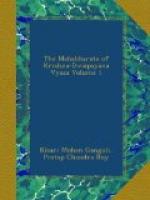“Rama said, ’If, O fathers, ye are favourably disposed towards me, the boon I ask is that I may be absolved from the sins born of my having annihilated the Kshatriyas in anger, and that the lakes I have formed may become famous in the world as holy shrines.’ The Pitris then said, ’So shall it be. But be thou pacified.’ And Rama was pacified accordingly. The region that lieth near unto those lakes of gory water, from that time hath been celebrated as Samanta-panchaka the holy. The wise have declared that every country should be distinguished by a name significant of some circumstance which may have rendered it famous. In the interval between the Dwapara and the Kali Yugas there happened at Samanta-panchaka the encounter between the armies of the Kauravas and the Pandavas. In that holy region, without ruggedness of any kind, were assembled eighteen Akshauhinis of soldiers eager for battle. And, O Brahmanas, having come thereto, they were all slain on the spot. Thus the name of that region, O Brahmanas, hath been explained, and the country described to you as a sacred and delightful one. I have mentioned the whole of what relateth to it as the region is celebrated throughout the three worlds.’
“The Rishis said, ’We have a desire to know, O son of Suta, what is implied by the term Akshauhini that hath been used by thee. Tell us in full what is the number of horse and foot, chariots and elephants, which compose an Akshauhini for thou art fully informed.’
“Sauti said, ’One chariot, one elephant, five foot-soldiers, and three horses form one Patti; three pattis make one Sena-mukha; three sena-mukhas are called a Gulma; three gulmas, a Gana; three ganas, a Vahini; three vahinis together are called a Pritana; three pritanas form a Chamu; three chamus, one Anikini; and an anikini taken ten times forms, as it is styled by those who know, an Akshauhini. O ye best of Brahmanas, arithmeticians have calculated that the number of chariots in an Akshauhini is twenty-one thousand eight hundred and seventy. The measure of elephants must be fixed at the same number. O ye pure, you must know that the number of foot-soldiers is one hundred and nine thousand, three hundred and fifty, the number of horse is sixty-five thousand, six hundred and ten. These, O Brahmanas, as fully explained by me, are the numbers of an Akshauhini as said by those acquainted with the principles of numbers. O best of Brahmanas, according to this calculation were composed the eighteen Akshauhinis




